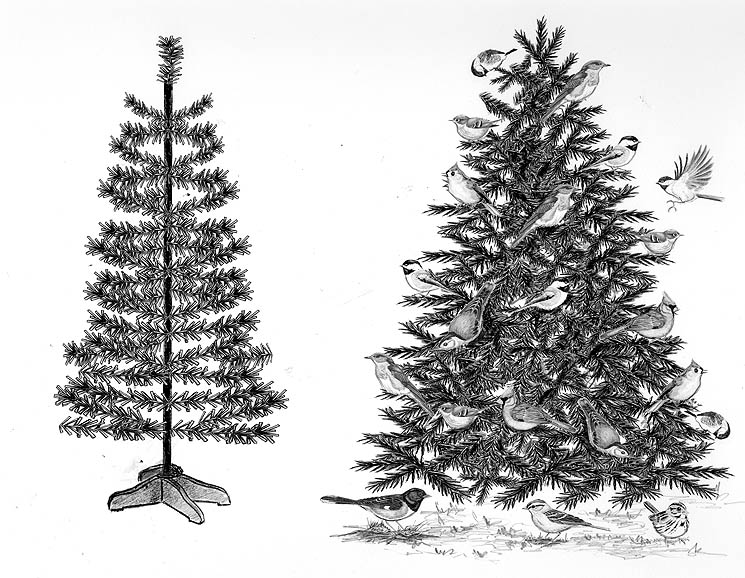
Dear Bird Folks,
Our family has always celebrated the holidays with a real, freshly cut Christmas tree. Lately, however, I’ve been feeling guilty about cutting down trees that birds may need. So, I am now considering buying a reusable artificial tree. What do you think?
– Ben, Truro, MA
Not again, Ben,
Is it really time to buy another Christmas tree? How did that happen so quickly? Remember when it was like forever between Christmases? Now Christmas seems to come every few months. At my house we used to store our holiday decorations up in the attic, hidden away in giant boxes. But now we just leave them in a pile in the garage because as soon as we take them down, we’ll have to put them back up. And just like you, I have been wondering if I’m doing the birds a disservice by encouraging millions of trees to be cut down each year. Should I switch to the dreaded, but perhaps more environmentally friendly, plastic tree? I need to decide quickly because Christmas is just a few days away and then a couple of weeks after that it will be next year’s Christmas…or so it seems.
One of my best birding buddies has a fit every time she sees a tree being cut down. She calls it a crime against nature. I’m a little more practical. I understand that trees provide us with lumber for our homes, for the pulp that this newspaper is printed on and for the toothpicks that hold my delicious soy bacon BLTs together. But do we really need to chop down millions of trees solely for temporary decorations? It turns out the answer is yes, at least when compared to the alternatives.
The first production of artificial Christmas trees began in the 1800s, when Germany started making trees out of goose feathers. (Goose feathers? Boo!) Then, in 1930, a British brush company did something nearly as creepy. They made Christmas trees out of toilet brush bristles. (How lovely.) Today, most artificial trees come from China, where they are produced in stinky factories, packed in containers, shipped across the ocean and ultimately sold in big box stores. Live trees, on the other hand, are grown on farms, often on small family farms. They are planted and harvested just like other crops such as apples, pumpkins and delicious soy bacon. Are tree farms beneficial to birds? Yes, in fact, they actually are. While grasslands are critical for meadowlarks, and thrushes seek dense forests, some birds require habitat that falls in between. A field of young trees is a magnet for grouse, waxwings, finches and woodcocks. At last count, the number of birds that are attracted to artificial tree factories remained at zero.
There are an estimated 350 million Christmas trees in various stages of growth in the United States. These trees not only provide food and shelter for birds, but they also filter out carbon dioxide and produce oxygen, which is an element I’ve heard good things about. Plastic trees do none of those things and probably contribute to pollution while being produced. Even though it can be correctly argued that plastic trees last longer, they don’t last forever. On average, people use pretend trees for about six years before getting a new one. And what do they do with their obsolete trees? Some folks probably just throw them in the trash, but that’s not very environmentally sound. Recycling synthetic trees is also tricky, since they are made of both plastic and metal. Which bin should they be tossed into? Conversely, the options for disposing of live trees are more plentiful, more earth-friendly and a lot more fun.
I typically set our old tree out by the bird feeder. It gives creatures an extra place to perch or hide from predators. Also, the old tree makes an attractive backdrop for photography. A bright red cardinal on a snow-covered Christmas tree is a great photo op. Or, with the help of a pair of pruners, you could easily snip off the branches and pile them up in the backyard. Juncos, sparrows and wrens all love a good brush pile. Alternatively, most municipalities welcome old trees and quickly turn them into chips and mulch for community parks and gardens. Just remember to remove all of the decorations. Mulch filled with tinsel and broken colored light bulbs is not as much fun as it sounds.
Freshly cut Christmas trees may be one of the last items that haven’t been gobbled up by the super stores and beaten down by the Internet. They are still readily available at small, local venues and garden shops or sold by various charities. When I was growing up my mother always insisted we get our tree from the local Episcopal Church. My mother was a hardcore Catholic, but since her church didn’t sell trees, she wanted her money to go to someplace spiritual. (Although, I think she was actually just hedging her bets for the afterlife.)
After doing a little research, Ben, I’ve decided to stay with real Christmas trees. Sure, they may cost more and can be a bit messy, but in the long run they support birds, the earth and the local community. Plus, it’s hard to beat bundling up on a cold December night and picking out a live tree with the entire family. That annual adventure provides more memories than dragging a boxed tree off a store shelf. But most importantly, real Christmas trees smell way better than anything else in nature…except for maybe soy bacon.